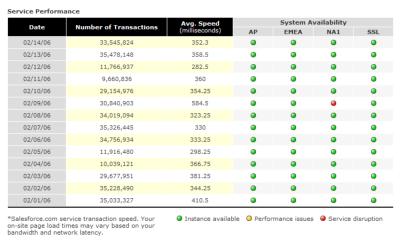Salesforce.com puts its reputation on (the) line

Full credit to Salesforce.com for transparency over outages at long last with the debut of its live system status page, which reports real-time and historic status information for each of its locations.
Any Web user — whether they're an employee, a customer, a prospective customer or even a competitor —Why put such sensitive information out there on the Web for all to see? can now visit this page to examine salesforce.com's current track record. They'll be able to see a continuously updated panel showing whether the system is up or down or has 'performance issues', along with historic information for each day over the past two weeks. There's also an information panel that shows how many transactions on a given day in the week (currently Monday) were API calls and how many were web page views.

Amongst the bank of green lights on the historic 'system availability' table, a single red light stands out like a beacon — the service disruption that affected some North America customers one week ago today. You can now click on that icon to find out what happened and what was the root cause. Scanning left along the line, you can also see the total number of transactions and their average speed for that day.
Comparing those figures to the previous Thursday suggests that Salesforce.com customers processed about four million fewer transactions than they would have done had the systems been functioning normally, which represents about 12% of the normal total. The average response time for those that did complete was about a third worse than normal, at 584.5 milliseconds (ie a bit more than half a second rather than the usual third of a second, excluding the time taken to transit the Internet connection between salesforce and the customer). Obviously this is an average, which means customers using the affected systems probably suffered much worse response times while others elsewhere continued to experience normal service.
Everyone knows that systems do go down from time to time (although the less often they go down, the better for everyone concerned of course). The only way to restore confidence is to make sure that, if it does happen, customers have the best possible information about what is going on. By making its systems status page public, Salesforce has gone one better. Customers now know that the company's reputation is on the line for all to see every moment that an outage continues. There is no better way of conveying to customers its commitment to fixing any service interruptions as rapidly as possible.